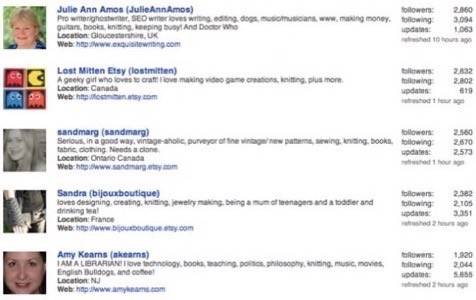Twitter has captured peoples’ imaginations like nothing else on the web in years. It’s growing fast, gets talked about all the time in other media, has fostered a huge developer community and gets used in more ways than anyone could have thought possible. It’s a great tool for journalists, for students, for knitters, for marketers and for people in many other walks of life.

What if the people working at Twitter Inc. aren’t using the service the way many of its power users are, though? We’ve examined the posting and following habits of people on the company’s staff and found that Twitter team members don’t follow very many other people, they aren’t following many of the top developers in their own community and they don’t even Tweet very much. This could be cause for concern among power users who depend on the service as it exists now, much less for those hoping it will be developed for even more powerful use cases.
Twitter co-founder, Jack Dorsey, said this week that he hopes the service will someday be just like electricity, something everyone uses but few feel the need to talk about. To follow that analogy, if you were someone who used a heavy duty washer and dryer in your home and found out that the electric company didn’t employ people who regularly used any appliances bigger than a toaster – wouldn’t you be a little concerned about the long term viability of your power supply?
Here are a few data points we’ve picked out, followed by a response we got from Twitter CEO, Evan Williams, when we asked about these issues.
Twitter’s employees don’t twitter very much. Looking over recent messages posted by the 49 people at Twitter Inc., you’ll see that the group as a whole averages about 100 to 150 messages per day, or 2 to 3 per person per day. That is very casual use. It’s ok to use Twitter mostly for listening, of course, and there are lots of people for whom 2 to 3 tweets per day feels like a lot. There are many, many people for whom 2 or 3 posts per day indicate health issues or alien abduction though (they usually tweet far more than that) and shouldn’t those people be concerned that no one at the company can relate to their experiences and needs? To be fair, some Twitter team members may never tweet while others tweet all day long and will stick up for the rest of us that do too. On average though, Twitter use at Twitter HQ doesn’t look like our experience with Twitter.

Twitter employees don’t follow very many other people. Twitter staff members tend to have a huge number of followers, but they don’t follow many people themselves. When we checked a few weeks ago only 2 out of 49 Twitter team members were following more than 500 people and no one was over 1k. That has since changed a little, it appears there are four staff people following 500 users and CEO @Ev is now following 1002.
That’s very unusual behavior on Twitter. Most people on staff are being followed by more than 1,000 people, many by tens or hundreds of thousands. To see how unusual that is – there are a total of 300 Twitter users who list themselves as living in California and who have more than 5,000 followers. 80% of those people are following 1k or more in return.
There are approximately 20 people on Twitter who identify themselves as fans of knitting and who have more than 1k followers. Every one of those extra-popular knitters are following more than 500 people themselves.
That means that while about 8% of Twitter staff (a popular group) are following 500 or more Twitter users, 100% of the popular knitters on Twitter are following 500 or more people. What’s up with that? (Stats compiled with the use of Tweepz, a great Twitter search engine.)
See also: the people most followed by Twitter staff.

Twitter staff members aren’t following top Twitter developers in the community. The Twitter API was the crown jewel of the company in the early pre-Oprah/Ashton days. Are the developers building on top of that API a valued part of the Twitter community though? We expected to see Twitter staff following some of those developers, but the numbers indicate that they are not.
We made a list of 8 of the top 3rd party Twitter development projects around the web (through our own perception of market leadership and a trip to delicious.com/popular/twitter) and then we found out who worked on those projects by searching the Twitter directory Twellow. We then cross referenced the list of people followed by Twitter staff members with the developer names for companies including Tweetdeck, Tweetmeme, Tweetie, Tweetgrid, Tweetstats, Seesmic, Tipjoy and Stocktwits.
The conclusion? 8 out of 49 people at Twitter are following someone associated with Tipjoy. It’s notable that Twitter and Tipjoy share common investors. 4 out of 49 people at Twitter follow Loic Le Meur of Seesmic, but he’s a Silicon Valley celeb. 4 out of 49 people at Twitter follow people working on Tweetie, the most popular Twitter app on the iPhone. One person follows members of the Tweetdeck crew, by far the most popular desktop app for using Twitter. One person! (That’s Doug Williams who does.)
None of the other leading Twitter developers we looked at were followed by more than one or two Twitter team members. That sounds to us like Twitter isn’t engaged in “that special Twitter way” with its own outside developers.
Evan Williams directed us to the @TwitterAPI account regarding this issue (and thanked us for pointing out that he wasn’t following the Tweetie team yet) but @TwitterAPI is following almost no one – it’s just a customer service line for developers, arguably not an active participant in the developer community.
Why Does This Matter?
Is it important that Twitter staff doesn’t include power users as we understand the term? Dave Winer once explained quite simply why the question of how Twitter is going to make money is important, a related question:
“it could turn out, when Twitter reveals its business model, that it’s something we don’t like. We won’t know where we, the users, fit in — until they tell us how they’re going to make money. And when they tell us, we may not like it.”
So too, if Twitter staff has a different understanding of its own technology, it’s liable to make decisions that negatively impact those of us who have radically different understandings. Twitter staff appears to use the service to communicate with their friends, with people they already know. That’s just a part of it for many of the rest of us; people also use it for serious business, for research, for alerting the public at large about important news – for all kinds of different things.
A difference in understanding between Twitter staff and power users may have been a big part of the recent blow-up over changes made to the public @ replies (a major issue!). Twitter’s particular vision for what many of us hope will be a long-term wide-open platform could have big consequences for things like bulk data analysis and historical archiving. Things could get real messy.
Think of the analogy above again: let’s say you use large quantities of electricity, in unusual but important ways. A power company that understands and supports that when it comes down to the smallest details is important. Twitter as power is not an unreasonable analogy – it’s a technology enabling a big new form of communication. A Twitter decision that gets @ replies or searches wrong for big users would be comparable to a WordPress (or Blogger.com) that gets decisions wrong concerning support for trackbacks or ping server relationships.
What Does Twitter HQ Have to Say About This?
We emailed Twitter about these discrepancies between the way they use the service and the way that many power users do and CEO, Evan Williams, was very gracious in responding. We’ll post his reply below for readers to consider for themselves.
“Hi, Marshall.
You bring up some interesting questions.
As you know, there are lots of different ways to use Twitter. Many people fall into the trap that you should follow all or most people back out of a sense of politeness or so-called engagement with the community. But the fact is, having more followers does not give you more time in the day (as much as I’d like to sell that). At a certain point, you’re not actually reading any more tweets by following more people — you’re just dipping into the stream somewhat randomly and missing a whole lot of what people say.
That’s fine, but I believe people will generally get more value out of Twitter by dropping the symmetrical relationship expectation and simply curating their following list based on the information and people they want to tune in to.
I follow almost 1,000 accounts. Among these, yes, there are celebrities (because I’m interested in how they’re using Twitter as well as what some of them have to say). There are Twitter developers. (You mentioned a few I don’t follow — there are several that I do.) I try to follow all Twitter employees, some potential employees, industry leaders, friends, family, and other people I care about, people (or organizations) who make me smarter, or people who make me laugh. It’s hard to know if this is the *right* set of accounts to follow. And I’m constantly curating my list. (In fact, I’m now following @atebits since you pointed it out. Account discovery is something we need to work a lot on.)
1,000 feels to me currently to be about the right number — but I still miss a lot. And other people (like Biz and other folks in the company) are comfortable with a much smaller number because they don’t want to miss as much.
Also, keep in mind that a following list does not reveal, necessarily, what one is paying attention to. Hundreds of people give me feedback by mentioning @ev — which I check many times a day. I also have saved searches for “twitter” and other related terms.
On the topic of developers, Biz and I aren’t a fair gauge on whether the company is paying attention to them. We find them incredibly important, but we aren’t able to pay enough attention to them, so we’ve hired people to do so full time. You’ll find the @twitterapi account replying to developers all day long, for instance. And that’s just one of our communication avenues.
I hope this addresses your questions.
Ev.
That’s a good response, but it sure seems to be based on a different understanding of Twitter than many power users and early adopters would offer. The idea that not following people is the best way to avoid missing things is very counter to the approach that other people take. That’s what groups are for, something hugely valuable that 3rd party desktop clients offer and the Twitter web interface does not. Ev and Biz Stone don’t appear to use desktop clients, though. Will they continue to offer the kind of technical support that desktop app power-users need? How about even better technical support to foster even more innovation? Those are the kinds of questions that arise when this service provider appears to be using its own service in a manner so different from the way that journalists, marketers, professional networkers and other power users use it.
You can find ReadWriteWeb on Twitter, as well as the entire RWW Team: Marshall Kirkpatrick, Bernard Lunn, Alex Iskold, Sarah Perez, Frederic Lardinois, Sean Ammirati, Doug Coleman, Jolie O’Dell, Dana Oshiro, Steven Walling and Lidija Davis.










